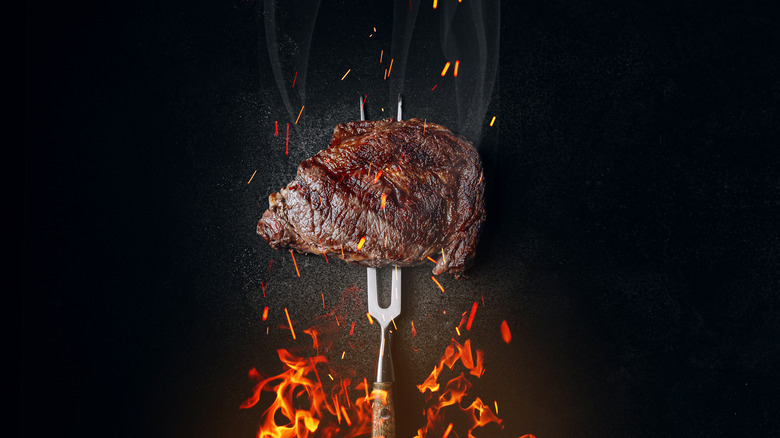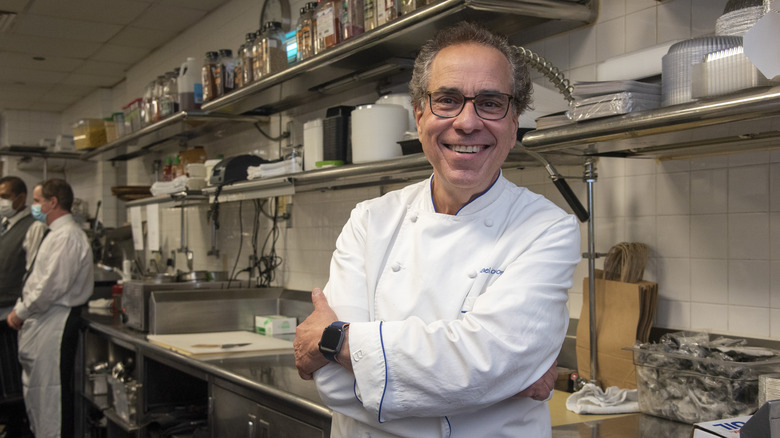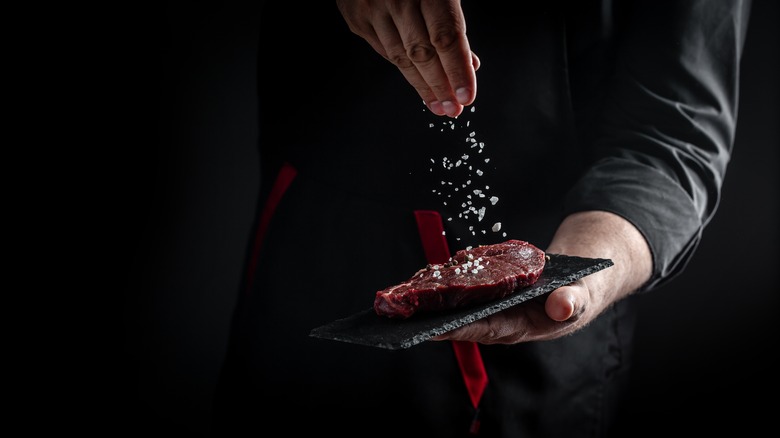The Secret To Grilling Steak Is All In The Preparation
Nothing elicits a gourmand's lust and acclaim more than a perfectly grilled steak. It's a dish that everyone should have in their arsenal if they wish to be taken seriously in the kitchen. Fortunately, cooking steak is much easier than some would have you think. With a bit of practice, you'll soon develop an instinct for it, and you'll be able to turn out perfectly grilled beef every time.
A few pointers from the experts will set you on the right track, so Chowhound reached out to chef Michael Lomonaco of Porter House Bar and Grill, the iconic steakhouse on Columbus Circle, with floor-to-ceiling views overlooking Central Park. Acclaimed as "the gold standard for the postmillennial, chef-drive, fat-cat New York steakhouse," by New York Magazine, Porter House is a haven for beef connoisseurs, and Lomonaco is a master of his craft. In his eyes, the perfect steak begins well before you even fire up the grill.
First steps
The first step in preparing a steak is one you might not think about, but it's arguably the most important: selecting the right cut of meat. "The standouts are strip steak, rib steak, and skirt steak," says Lomonaco. "My favorite cut for the grill is a thick-cut 1½-inch Prime Rib Steak on the bone. A reliably juicy and beefy cut, the marble of fat content adds to the overall great palate pleasure and the inherent tenderness is always memorable."
If you are cooking for a crowd, he recommends flank steak, the customary choice for fajitas, as it cooks quickly and is far more tender than other large cuts like the London Broil of Chuck. However, Lomonaco encourages novice grillers to make use of these less expensive cuts as they hone their skills before trying out pricier cuts like rib steaks and strip steaks.
When shopping for steaks, Lomonaco doesn't put quite as much stock into beef grading as some other chefs might. The USDA assigns three grades to beef: select, choice, and prime. Prime denotes the best cuts, typically defined by intense marbling, but it comes at a much higher price, particularly when you're buying prized cuts like New York strip and ribeye steak. But Lomonaco says the priciest cuts aren't always necessary. "Choice rib steak," he argues, "should not disappoint even the most discriminating diner."
Preparing your meat and your grill
How you prepare your meat is just as vital as choosing the right cut. First, you should have your steak prepped and ready to cook before you start the grill. Lomonaco emphasizes the importance of letting your meat come to room temperature before cooking. "If you go straight from the fridge to the grill, the center of the steak is dead-cold and it will throw off your process. I recommend 10 minutes at kitchen room temperature to ensure that you don't over char the outside while trying to get to your preferred internal temperature."
As far as seasoning goes, Lomonaco says to keep it simple. "Season your steaks with coarse salt only. Well-seasoned steaks are best with salt alone as pepper will burn." Marinades and wet rubs can lend additional layers of flavor to the beef, which is helpful in lean cuts, but they can also be tricky to cook. "Be especially careful of wet rubs and marinades as they can flare up and burn even before your steak has fully cooked," warns Lomonaco.
It's essential to preheat the grill, whether you're using charcoal, wood, or gas. "Close the cover on the gas grill and get it to 800 degrees Fahrenheit. Get your briquettes nice and white with ash, and your wood chunks should also get to the red-hot stage before grilling," Lomonaco advises. You must also be sure to clean the grill after every use, as the "[The] first principle of great grilling technique is to start with a clean grill."
Individually, each of these preparatory steps is quite small, but together the right cut of meat, the right seasonings, and a grill prepped in the right way will set you up to prepare a great steak.


